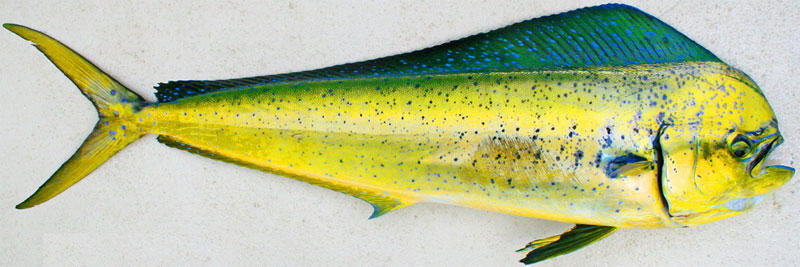
Download the mobile app!
Hooking Up Anglers Since 2011.
Check out our new Android or iOS app for Fishing Status.
The long awaited return of our mobie app is back on Apple App Store and Google Play
Mahi-mahi
Species Information
| Scientific Name: | Coryphaena hippurus |
| Common Names: | mahi, dolphin, dolphinfish, mahi mahi, dorado, goldmakrele, shiira, lampuga, lampuka, lampuki, rakingo, calitos, maverikos |
| Environment: | Nearshore, Offshore |
| Ideal Temp: | 70-80°F (21-26°C) |
About Mahi-mahi
The mahi-mahi or common dolphinfish is a surface-dwelling ray-finned fish found in off-shore temperate, tropical and subtropical waters worldwide. Also known widely as dorado, it is one of only two members of the Coryphaenidae family, the other being the pompano dolphinfish.
Mahi-mahi live 4 to 5 years. Catches average 7 to 13 kilograms (15 to 29 lb). They seldom exceed 15 kilograms (33 lb), and mahi-mahi over 18 kilograms (40 lb) are exceptional.
Mahi-mahi have compressed bodies and long dorsal fins extending nearly the entire length of their bodies. Their caudal fins and anal fins are sharply concave. They are distinguished by dazzling colors: golden on the sides, and bright blues and greens on the sides and back. Large males have high, vertical foreheads, while the female's forehead is rounded. Males grow larger than females.
The name mahi-mahi means very strong in Hawaiian. They are extremely fast swimmers and feed extensively on flying fish and squid as well as on other small fish. Mahi-mahi are highly sought for sport fishing and commercial purposes. Sport fishermen seek them due to their beauty, size, food quality, and healthy population. Mahi-mahi is popular in many restaurants.
Mahi-mahi can be found in the Caribbean Sea, on the west coast of North and South America, the Pacific coast of Costa Rica, the Gulf of Mexico, the Atlantic coast of Florida, Southeast Asia, Hawaii and many other places worldwide.
Fishing charters most often look for floating debris and frigatebirds near the edge of the reef in about 120 feet (37 m) of water. Mahi-mahi (and many other fish) often swim near debris such as floating wood, palm trees and fronds, or sargasso weed lines and around fish buoys. Sargasso is floating seaweed that sometimes holds a complete ecosystem from microscopic creatures to seahorses and baitfish. Frigatebirds dive for food accompanying the debris or sargasso. Experienced fishing guides can tell what species are likely around the debris by the birds' behavior.
Thirty- to fifty-pound gear is more than adequate when trolling for mahi-mahi. Fly-casters may especially seek frigatebirds to find big mahi-mahis, and then use a bait-and-switch technique. Ballyhoo or a net full of live sardines tossed into the water can excite the mahi-mahis into a feeding frenzy. Hookless teaser lures can have the same effect. After tossing the teasers or live chum, fishermen throw the fly to the feeding mahi-mahi. Successful fishing methods include trolling surface baits (flying fish, mullet, balao, squid, strip baits) or artificial lures; also live bait fishing or casting.
Once on a line, mahi-mahi are fast, flashy and acrobatic, with beautiful blue, yellow, green and even red dots of color.
Hooked dolphin may leap or tailwalk, darting first in one direction, then another. It is believed that they can reach speeds up to 50 mph (80.5 kph) in short bursts. If the first dolphin caught is kept in the water, it will usually hold the school, and often others will come near enough to be caught by casting.
Mahi-mahi Fishing
| World Record: | 39.46 kg (87 lb 0 oz) Papagallo Gulf , Costa Rica |
| # Fish Caught: | 1875011 documented in database. |
| Earliest Record: | 7/2/1758 12:00:00 PM and located at 10.00000, 93.00000. |
| Latest Record: | 4/4/2025 2:06:12 AM and located at -31.82141, 115.73853. |
| Common Techniques: | Casting, Fly, Trolling |
| Popular Lure Types: | Flies, Plugs, Trolling |
| Fishing Spots: | 3963 Mahi-mahi fishing spots. |
Latest Mahi-mahi Fishing Reports and Spots
We had an exciting day out on the Pacific with Big Eye 2 Sportfishing just 20 miles off the coast of Quepos Costa Rica. Our seasoned captain Fr (
View)
Season’s Greetings from Marlin My Darlin the premier family fishing charter in Fort Lauderdale! This Christmas season our fishing charters are (
View)
Baitfish of the Florida Keys: A Local Angler’s Guide When people think about fishing in the Florida Keys the spotlight usually shines on sailfis (
View)
Today we had the pleasure of hosting a group of enthusiastic anglers from Canada aboard the Big Eye 2. The day was marked by a successful haul (
View)
Today was another exciting day out on the waters of Quepos Costa Rica with Big Eye 2 Sportfishing. As your experienced captain I Franklin Araya (
View)
The Peak of Winter Action in Puerto Vallarta
Hello, Anglers! Captain Pete here, reporting on what is shaping up to be a phenomenal winter se (
View)
Today was another spectacular day for sport fishing aboard the Big Eye 2 in the beautiful waters of Quepos Costa Rica. As the owner and operato (
View)
Today was an exceptional day out on the waters of Quepos Costa Rica aboard the Big Eye 2. Our regular guest John who has been fishing with us f (
View)
Today was another exciting day of sport fishing aboard the Big Eye 2 in the beautiful waters of Quepos Costa Rica. As your Captain Franklin Ara (
View)
Today’s sport fishing adventure aboard the Big Eye 2 in the stunning waters of Quepos Costa Rica was nothing short of spectacular. As the owner (
View)